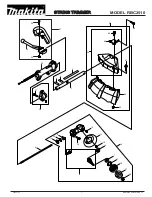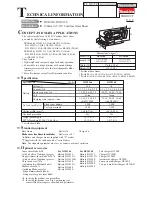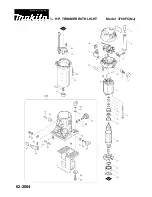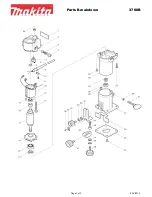
OPERATION
SAFETY GUARD
LINE TRIMMING CUT-
OFF BLADE (FIG. 7)
This trimmer is equipped with a line trimming cut-off blade
on the safety guard.. For best cutting, advance line until
it is trimmed to length by the cut-off blade. Advance line
whenever you hear the engine running faster than normal.
This will maintain best performance and keep line long
enough to advance properly.
MAINTENANCE
WARNING:
Use only original manufacturer's replacement parts,
accessories and attachments. Failure to do so can
cause possible injury, poor performance and may
void your warranty.
You may make adjustments and repairs described here.
For other repairs, have the trimmer serviced by an
authorizedservicingagent.
Consequences of improper maintenance may include
excess carbon deposits resulting in loss of performance
and discharge of black oily residue dripping from the
muffler.
Make sure all guards, straps, deflectors and handles are
properly and securely attached to avoid the risk of
personalinjury.
SPOOL REPLACEMENT
EZ LINE
TM
TAP ADVANCE SYSTEM
NEW PREWOUND SPOOL (FIG. 10 & 11)
If replacing line only, refer to "Line Replacement" later in
this manual.
Use only 2.0 mm
diameter monofilament line.
Use the manufacturer's replacement line for best perfor-
mance.
NOTE:
If the line is worn too short you may not be able to
advance the line by tapping it on the ground. If so, STOP
THE ENGINE, and manually advance the line.
ADVANCING THE
LINE
MANUALLY
Push the bump knob down while pulling online(s) to
manually advance the line.
CUTTING TIPS (FIG. 6)
Keep the trimmer tilted toward the area being cut; this is
the best cutting area (28).
Do not cut in dangerous cutting area (27).
Use the tip of line to do the cutting; do not force bump
head into uncut grass.
Wire and picket fences cause extra line wear, even
breakage. Stone and brick walls, curbs, and wood may
wear line rapidly.
Avoid trees and shrubs. Tree bark, wood moldings,
siding, and fence posts can easily be damaged by the
line.
- 5 -
STARTING AND STOPPING (FIG. 8 & 9)
WARNING
Never start or run the engine inside a closed or poorly
ventilated area; breathing exhaust fumes can kill.
TO START A COLD ENGINE:
1. Lay trimmer on a flat, bare surface. Press switch (4) to
"I"
(RUN)
position.
NOTE:
Unit is equipped with a positive on-off switch,
make sure switch is in the "I" (RUN) position before
starting the unit.
2. Push primer bulb (19)
8 to 10 times.
3. Set choke lever (15) to full choke position ( )(18).
4. Depresssafety button (5),squeezetrigger (3) and pull starter grip (1)
until engine tries to run. (No more than 6 pulls.)
5. Set choke lever to half choke position (
) (17)
.
6. Hold trigger and pull starter grip until engine runs.
7. Run engine 15 to 30 seconds at full throttle (with trigger
depressed fully) on half choke position (
) to warm
up. Move choke lever to run position ( ) (16).
TO START A WARM ENGINE:
2. Move choke lever to run position ( ).
3. Hold trigger and pull starter grip until engine runs.
TO STOP THE ENGINE:
To stop the engine, depress the switch to
"O"
position.
NOTE:
Be sure to return the stop switch to the "I" (RUN)
position before trying to start unit.
Remove the emptyspool (31)from the bumphead.Keep
thespring (35) attached to the spool.
Stop the engine, disconnect thesparkplugwire.Hold
thebump head (33)andunscrew thebump knob (30). Turn
clockwise.
NOTE:
If the engine fails to start, immediately repeat steps
3 – 6 or refer to the TROUBLE SHOOTING at the back of
this manual. As the engine could be flooded, faulty or worn
spark plug, low or incorrect fuel or is in need for a service.
NOTE:
Do not pull the starter grip any more than 5 times
as more than this can cause the engine to flood. If the
engine fails to start after 3 – 5 pulls, immediately repeat
steps 5 – 8.
1. Press swith (4) to "I" (RUN) position.
Summary of Contents for PLT-3043YW
Page 1: ...PLT 3043YW TRIMMER OWNER S OPERATION MANUAL N197 ...
Page 3: ...Fig 7 Fig 9 Fig 10 Fig 8 5 4 3 Fig 6 29 28 27 30 20 Fig 11 32 31 35 34 33 32 16 17 18 19 15 ...
Page 4: ...Fig 13 Fig 14 Fig 15 Fig 12 35 31 36 47 37 37 41 38 36 34 Fig 16 39 40 Fig 17 41 42 43 ...
Page 5: ...Fig 18 44 45 46 ...
































